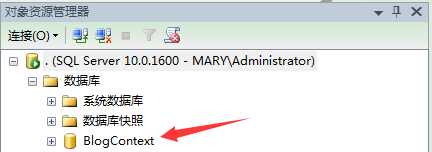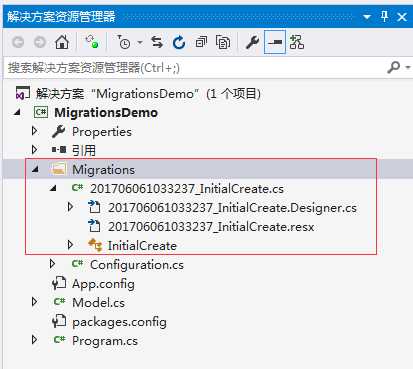Entity Framework Code First Migrations 官方Demo
Posted
tags:
篇首语:本文由小常识网(cha138.com)小编为大家整理,主要介绍了Entity Framework Code First Migrations 官方Demo相关的知识,希望对你有一定的参考价值。
一、建立初始模型和数据库
1、创建一个新的控制台程序 MigrationsDemo 。
2、安装最新的 EntityFramework NuGet 程序包
打开程序包管理器控制台 -> 运行命令 Install-Package EntityFramework
3、创建名为 Model.cs 的文件,代码如下,其中定义了一个组成领域模型的 Blog 类,和一个 EF Code First 上下文类 BlogContext 。
1 using System.Data.Entity; 2 using System.Collections.Generic; 3 using System.ComponentModel.DataAnnotations; 4 using System.Data.Entity.Infrastructure; 5 6 namespace MigrationsDemo 7 { 8 public class BlogContext : DbContext 9 { 10 public DbSet<Blog> Blogs { get; set; } 11 } 12 13 public class Blog 14 { 15 public int BlogId { get; set; } 16 public string Name { get; set; } 17 } 18 }
4、更改 Program.cs 文件的代码
1 using System; 2 using System.Collections.Generic; 3 using System.Linq; 4 using System.Text; 5 6 namespace MigrationsDemo 7 { 8 class Program 9 { 10 static void Main(string[] args) 11 { 12 using (var db = new BlogContext()) 13 { 14 db.Blogs.Add(new Blog { Name = "Another Blog " }); 15 db.SaveChanges(); 16 17 foreach (var blog in db.Blogs) 18 { 19 Console.WriteLine(blog.Name); 20 } 21 } 22 23 Console.WriteLine("Press any key to exit..."); 24 Console.ReadKey(); 25 } 26 } 27 }
5、配置 App.config 中的数据库连接字符串(与本地SqlServer数据库连接)。
1 <configuration> 2 <connectionStrings> 3 <add name="BlogContext" connectionString="Data Source=.;Initial Catalog= BlogContext;Integrated Security=True" providerName="System.Data.SqlClient" /> 4 </connectionStrings> 5 </configuration>
6、运行程序,在SqlServer中自动生成数据库。

二、实现迁移
向 Blog 类添加 Url 属性。
public string Url { get; set; }
如果直接运行程序,会报错。

实现上下文的迁移:打开程序包管理器控制台 -> 运行命令 Enable-Migrations
命令执行后,在项目中生成了一个 Migrations 文件夹,包含两个文件:Configuration 类,InitialCreate迁移。

多个模型指向同一个数据库
在 Configuration 文件中,包含了 ContextKey 属性,作为 Code First 模型的唯一识别符。
三、生成并运行迁移
Code First 迁移有两个主要命令:
Add-Migration :基于上次迁移后所作出的改变,搭建接下来的迁移支架。
Update-Database :将所有的待执行迁移应用到数据库
1、在程序包管理器控制台执行命令 Add-Migration AddBlogUrl (AddBlogUrl :Add-Migration 允许我们给这些迁移命名)。
2、在 Migrations 文件夹中,生成了AddBlogUrl 迁移,如下所示。
1 namespace MigrationsDemo.Migrations 2 { 3 using System; 4 using System.Data.Entity.Migrations; 5 6 public partial class AddBlogUrl : DbMigration 7 { 8 public override void Up() 9 { 10 AddColumn("dbo.Blogs", "Url", c => c.String()); 11 } 12 13 public override void Down() 14 { 15 DropColumn("dbo.Blogs", "Url"); 16 } 17 } 18 }
3、执行命令 Update-Database,数据库被更新(Blogs 表中包含了 Url 列)。
四、定制迁移
在 Blog 类中添加 Rating 属性
public int Rating { get; set; }
添加一个新的 Post 类
1 public class Post 2 { 3 public int PostId { get; set; } 4 [MaxLength(200)] 5 public string Title { get; set; } 6 public string Content { get; set; } 7 8 public int BlogId { get; set; } 9 public Blog Blog { get; set; } 10 }
在 Blog 类中添加 Posts 集合,来建立 Blog 和 Post 之间的关系
public virtual List<Post> Posts { get; set; }
执行命令 Add-Migration AddPostClass
但是,我们可能需要做一些改变:
1、为 Posts.Title 列添加唯一索引 (如代码22和29行所示)
2、添加一个不为空的 Blogs.Rating 列 (如代码24行所示设置默认值)
1 namespace MigrationsDemo.Migrations 2 { 3 using System; 4 using System.Data.Entity.Migrations; 5 6 public partial class AddPostClass : DbMigration 7 { 8 public override void Up() 9 { 10 CreateTable( 11 "dbo.Posts", 12 c => new 13 { 14 PostId = c.Int(nullable: false, identity: true), 15 Title = c.String(maxLength: 200), 16 Content = c.String(), 17 BlogId = c.Int(nullable: false), 18 }) 19 .PrimaryKey(t => t.PostId) 20 .ForeignKey("dbo.Blogs", t => t.BlogId, cascadeDelete: true) 21 .Index(t => t.BlogId) 22 .Index(p => p.Title, unique: true); 23 24 AddColumn("dbo.Blogs", "Rating", c => c.Int(nullable: false, defaultValue: 3)); 25 } 26 27 public override void Down() 28 { 29 DropIndex("dbo.Posts", new[] { "Title" }); 30 DropIndex("dbo.Posts", new[] { "BlogId" }); 31 DropForeignKey("dbo.Posts", "BlogId", "dbo.Blogs"); 32 DropColumn("dbo.Blogs", "Rating"); 33 DropTable("dbo.Posts"); 34 } 35 } 36 }
现在,迁移已编辑好,执行命令 Update-Database –Verbose
PS:加上 –Verbose 可查看 Code First Migrations 运行的SQL
五、数据移动/定制SQL
添加 Post.Abstract 属性,稍后将从 Content 列中获取数据赋给 Abstract
public string Abstract { get; set; }
执行命令 Add-Migration
将每一个post中的content 的前100个字符赋给Abstract (如第12行代码所示)
1 namespace MigrationsDemo.Migrations 2 { 3 using System; 4 using System.Data.Entity.Migrations; 5 6 public partial class AddPostAbstract : DbMigration 7 { 8 public override void Up() 9 { 10 AddColumn("dbo.Posts", "Abstract", c => c.String()); 11 12 Sql("UPDATE dbo.Posts SET Abstract = LEFT(Content, 100) WHERE Abstract IS NULL"); 13 } 14 15 public override void Down() 16 { 17 DropColumn("dbo.Posts", "Abstract"); 18 } 19 } 20 }
执行命令 Update-Database –Verbose
六、迁移到特定版本(包括降级)
假设需要把数据库状态还原到运行AddBlogUrl 迁移之后,可以用–TargetMigration
运行 Update-Database –TargetMigration: AddBlogUrl
这个命令将运行 AddBlogAbstract 和 AddPostClass 的 Down script
如果要一路回滚到空数据库,则可执行 Update-Database –TargetMigration: $InitialDatabase
以上是关于Entity Framework Code First Migrations 官方Demo的主要内容,如果未能解决你的问题,请参考以下文章